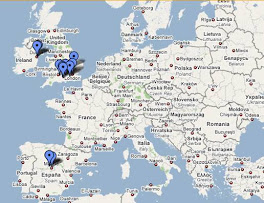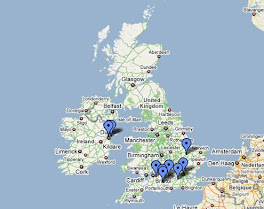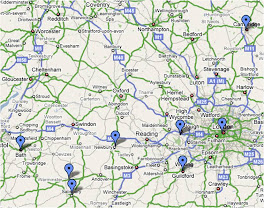Feeling the ear-popping sensation of aerial descent, I woke up to the most beautiful sunrise that I have ever seen above the clouds of Ireland. Catching a glimpse of the sunrise over England earlier in the morning, my plane was plunged into darkness as we flew away from the rising sun. Morning caught up with us, however, and I saw a phenomenon never before experienced in my lifetime -- two sunrises in one day. Needless to say, any sunrise seen above miles of fluffy clouds is positively breathtaking.
Landing at Dublin International Airport around 7:30 a.m., I rubbed the sleep from my eyes and eventually made my way to the Irish customs gate to get the second international stamp pressed into my passport this semester (the British stamp was my first). After taking a few moments to freshen up in the ladies' room, I hopped on a bus bound for the heart of southern Ireland's capital city.
By the time that I reached the city center, the streets of Dublin were already bustling with people buzzing off to work and school. Prioritizing my time, I first located an internet cafe to send a few quick messages to family and friends just to let them know that I had arrived safely in Ireland. (My parents and Craig were probably both a little concerned when I frantically told them the night before that I was making a last-minute trip to Dublin by myself.) Thankful for a few brief minutes of internet access, I left the cafe in search of a hearty Irish breakfast to satisfy my rumbling appetite. Finding a comfortable cafe near the Liffey River in the heart of Dublin, I relaxed in the cozy cafe atmosphere while nibbling on a filling breakfast of hashbrowns, scrambled eggs, sausage, and toast. Feeling instantly re-energized, I flipped through a tour book and was soon ready to tackle the major sites of Dublin.
My first place of interest was Trinity College and the Book of Kells. Trinity College is Ireland's most prestigious university with its stately buildings and rich history. With backpack in tow, I easily fit in with the other students heading off to class. Having arrived 45 minutes before the first campus tour, I settled down in a small campus coffee shop to enjoy a large Chai latte. (A huge fan of Chai tea, I must say that the free-trade Chai latte served at this coffee shop far surpassed any Starbuck's Chai that I've ever had back in the States.) Feeling like a true Trinity student, I spent another few minutes looking over notes for my micronutrients class before catching a 10:15 tour of the campus.
Doling out 10 Euro for a tour of campus and admission to the Book of Kells exhibit, I finally started to take in the stately buildings of Trinity College as our dynamic tour guide began a lively narration of its rich history and interesting quirks. The most interesting story involved a former provost of Trinity College named George Salmon. When southern Ireland was still under British rule at the beginning of the twentieth century, the reigning monarch of the United Kingdom decreed that women be allowed to attend lectures at all British universities. Upon hearing this decree, Provost Salmon exclaimed, "Women will enter this college over my dead body." Enraging the Irish female population at a time when the women's suffrage movement was sweeping across the United States, passionate letters were sent to the British parliament begging permission for women to attend Trinity College. These letters were passed to King Edward VII, who consequently ordered Provost Salmon to allow women to enter his college. Seeing his motives forcefully stamped upon, Provost Salmon signed the decree allowing women to attend Trinity College, but he is quoted as saying, "My hand agrees, but my heart adamantly objects." Ironically, George Salmon died less than a year after signing this decree, and the first woman enrolled at Trinity College only a month after his death. To this day, I bet that George Salmon is rolling in his grave to know that women were allowed on campus "over his dead body".
The tour of Trinity College reminded me a lot of our tour of Cambridge University with its many buildings and little-known stories. However, this tour was much shorter (~30 minutes) and involved a glimpse of the Book of Kells. Prior to traveling to Ireland, I had never heard of the Book of Kells and was curious to learn more about its unique story. The Book of Kells is an ornate handwritten manuscript of the four gospels that was completed around AD 800 by Celtic monks in Scotland. Fleeing frequent Viking attacks, the monks relocated the ceremonial bible to the Abbey of Kells in County Meath, Ireland (hence the book's current name). Free from the Vikings, the Book of Kells resided in the abbey for many safe years during the Medieval era. Unfortunately, greed often rules over rational thought, and the Book of Kells was stolen from its safe resting place in the eleventh century AD. Why would anyone want to steal a handwritten bible? The thieves were probably asking themselves this same question after they had ripped the book from the abbey walls. Though an artistic masterpiece, the Book of Kells held little monetary value in the second century. For the most part, the four gospels were used for sacramental purposes. The wooden chest that held the book, however, was covered in gold and jewels that would attract even the most repentant of thieves. Wanting the Book of Kells for only its casing, the thieves felt no guilt at removing the gold and jewels for their own pleasure. However, they appeared to be frightened by the wrath of God incited at pilfering the most famous bible in all of Ireland. Want to dispose of the book as quickly as possible, they wrapped the Book of Kells in leather and buried it deep in an Irish field. Nearly 300 years later, a farmer was plowing in his field when he unearthed the unlikely package and was amazed to discover one of Ireland's long-lost treasures. Rewarding him with a hefty sum for the safe return of the book, the governor of Kells sent the book to Trinity College in Dublin where the famous bible has resided ever since. For ease of display and preservation, the Book of Kells has been physically split in four portions roughly coinciding with the four gospels. After viewing the book myself, I was amazed to see Latin script that is as vivid today as it was nearly 1200 years ago.
Still full from my earlier mid-morning brunch, I decided to delay lunch in order to grab a few extra minutes in the Irish Museum of Modern Art (IMMA). As a systematically-thinking engineer, I'm not a huge fan of modern art mainly because it doesn't make sense to me. Before any die-hard art-lovers roll their eyes at the previous sentence, I will say that there is a difference in the art world between understanding modern art and feeling the effects of modern art. Considered to be one of the best collections of modern art in Europe, I can't really begin to describe the IMMA pieces -- mainly because I don't know how to describe them. However, I did find it interesting that several of the artworks utilized media such as video, lights, and rotating mobiles rather than paint and canvas as I was expecting. Emotionally moving, many of the pieces portrayed the oppression of women and natives of third world countries. Rather than experiencing the euphoria created by the masterpieces of DaVinci and Michaelangelo, these modern works left me feeling rather humbled and somewhat depressed. Searching for some shred of hope in the artists' interpretation of the modern world, I seemed to fall short of finding any beauty in the explicit display of human suffering. A trained artist eye may have been able to point out the artists' true meanings behind their works, but by myself, I found several of the pieces to be extremely dark and ominous. I don't regret taking a few side streets in Dublin to explore the modern art museum, I just fear that modern art is perhaps one side of culture that I fail to fully appreciate.
Giving in to a growing appetite, I surrendered to the overpriced museum cafe and recovered from my bout with modern art over a steaming baked potato and chef salad. Popping the last bites of buttered potato into my mouth, I left the Irish Museum of Modern Art in pursuit of Dublin's biggest tourist attraction -- the Guinness Storehouse. To be completely truthful, I extremely dislike the taste of beer. With so many flavorful wines and liquors on this planet, why would I waste my time trying to learn how to drink a beverage that tastes like contaminated water? When I mentioned to my British friends that I was planning to skip the Guinness storehouse on my trip to Dublin, I was met with incredulous gasps of surprise and frantic urges not to miss the headquarters of Ireland's premier stout. Taking their unbending advice, I walked a few blocks from the modern art museum only to wait in line for entrance into the largest museum of Guinness paraphernalia in the world. Arthur Guinness, the first master brewer and founder of Guinness beer, first moved to Dublin in 1759 after inheriting a small fortune from the Archbishop of Cashel (his godfather). Taking his inheritance (only $200 at the time), Arthur signed a 9000 year lease at St. James's Gate with access to the city's watercourse, thus beginning an enterprise that has far exceeded his lifetime. Today, Guinness beer is still brewed fresh everyday at St. James's Gate in Dublin and is considered to be the best home-brewed beer in all of Ireland. Because Guinness reputably does not travel well, fans of this stout claim that the best Guinness beer can only be tasted in Dublin. As for myself, all forms of Guinness are too bitter for my taste buds. The Guinness storehouse was comprised of seven stories devoted to Ireland's favorite stout. Like most museums, the ground level was home to the ticket counters and gift shop. After briefly perusing through overpriced Guinness gifts and mementos, I trekked up the stairs for an education in Irish beer. The second story was devoted to the ingredients and methods for brewing stout. Having visited a few breweries in the States, the exhibits didn't tell me much that I hadn't already seen before -- hops, yeast, water, and barley. However, the giant waterfall in the middle of the second floor was neat to see regardless of the over-described idiosyncrasies of brewing. Up from the second level, the next four floors described the history, advertising, and health effects of beer. Interestingly, the early slogan "Drink Guinness -- It's good for your health!" arises from the fact that Irish doctors would often prescribe a daily pint of Guinness to their patients to induce feelings of euphoria which often result from alcohol consumption. Seeing their patients feel genuinely happier after a pint of beer, Guinness prescriptions were rather common and wide-spread in Ireland for several years. Working in the medical field, I could only laugh at this belief and think, "Wow, times have really changed!" Finishing my tour beer memorabilia, I jumped up to the top floor of the storehouse for my "free" pint of Guinness and the best view of Dublin. The Guinness Storehouse bar was an experience in itself. Crowded with dozens of tourists and local Dubliners, the bartenders topped off pints of Guinness while an Irish band belted out tunes to several Gaelic drinking songs. The accordion and throaty Gaelic mix was quite charming as I made a brave attempt to stomach a pint of Guinness's finest pint in Ireland. Looking through glass walls at the city below, I felt that my 10 Euro admission ticket had at least paid its price in bar culture and scenic view. My only wish is that I could've enjoyed the taste of frothy Irish stout...
Feeling proud that I had at least managed to sip through a fifth of my Guinness pint, I returned my almost-full glass to the bar and headed back to the city. (In hindsight, I'm actually glad that I didn't drink an entire pint of beer that afternoon. Functioning on barely three hours of sleep, any large amount of alcohol would have gone straight to my head -- not a good idea for any lady touring an unfamiliar city by herself.) Taking advantage of the last minutes of daylight, I stopped into a couple Irish souvenir shops to buy a few characteristic Irish items before checking into my hostel for the evening. Completely exhausted from my sleepless trip the night before, I climbed into my bunk bed for an early evening nap.
I awoke an hour or so later to one of my roommates gabbing with a friend on her cellphone. Feeling relatively refreshed, I grabbed my first shower in 36 hours and chatted with three of my hostel roommates before heading out for the evening. Originating from Australia, England, and Portugal, all three were traveling solo throughout Europe. (For those of you who are unfamiliar with hostel culture, the concept of a hostel is to provide cheap accommodation for typically young European travelers. To cut costs and save space, hostel owners outfit a single room with several bunk beds, which translates into sharing a room with anywhere from 2 to 15 strangers. Though this may sound odd to many Americans, hostels are rather safe and a cheap option for heavy-sleepers.) Knowing that Bill's plane was scheduled to touch down in Dublin around 8 o'clock, I took a brisk walk downtown in search of a bite to eat before his arrival. Feeling slightly homesick in a city by myself, I did the unthinkable act of walking into Burger King and glancing through an American fast food menu. As I had expected, the Irish Burger King menu was quite different from the typical American version. Ordering a spicy chicken baguette with peri-peri sauce, I settled into a corner of the restaurant with my tour book to plan the next day's Dublin outing with Bill. With still an hour to spend after finishing my sandwich and fries, I ordered a cup of ice cream and continued to read through pages of Dublin attractions and Irish history.
Feeling the buzzing of a cell phone in my pocket, I paused in my tourist reading to send a quick response to Bill's text message that he had arrived in Dublin. For some odd reason, our cell phones allowed us to text each other though we couldn't dial international calls to talk voice-to-voice. After a dozen of lengthy text messages, we found each other near the river and headed off for a bit of city nightlife. Looking traditional Irish bar music, we eventually found a crowded pub with a live band and a pair of Irish dancers. Ordering a glass of Jameson's and ginger ale, I developed a nice affinity for Irish whiskey and joined the bar crowd in belting the chorus to several popular tunes (several of which were American, ironically). When the band needed a break to rest their voices, dancers took the stage for an impressive show of traditional Irish dancing. An energetic atmosphere, Bill and I quickly found ourselves thrust in the heart of Irish culture -- drinking, dancing, and lively music. Enjoying several hours at the bar, I eventually began to feel the effects of a busy day with only snatches of sleep. Begging Bill to cut our evening slightly shy of midnight, we walked back to the hostel where I dragged myself into bed and curled up for a much-needed night of sleep.
Subscribe to:
Post Comments (Atom)











No comments:
Post a Comment